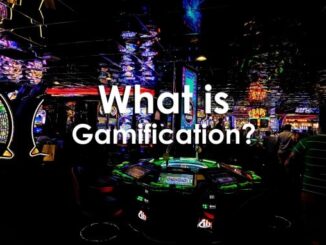
This article was originally published at UniversityXP and is re-published in Ludogogy by permission of the author.
The player experience is something that we all shoot for in game design. That’s because the player experience is what the player goes through when they play the game.
That experience can be as simple as gamified mechanics in gamification; a games-based learning class; a simulation; or a serious game. The player experience dictates how our creation, our game, is received by our users.
The player experience can be broken down into six major areas which include:
1. Motivation
2. Meaningful Choices
3. Balance
4. Usability
5. Aesthetics
6. Fun
Here’s a review of these six major areas of the player experience and what it’s like to design for them.
Motivation

To address motivation you have to ask the question: “Why is the player playing the game?” For an entertainment game it could be for the player to try something different; to escape from their everyday realities; or to satisfy their own curiosity.
For simulations; serious games; or games-based earning that motivation will be different. They could be playing as part of a class, work, or another reason that isn’t entirely clear yet.
No matter the application, we can determine that that their motivation is based on at least two different areas. Those two areas include: interest and a demonstration of competence.
Interest is the factor that most applies mostly to entertainment games. That is because the player is interested in the game and wants to be part of the experience. Demonstration of competence is different. When players demonstrate their competence they are motivated to play and do well. But to continue playing and improve.
This underlying motivation is important for players to return, progress, and keep playing our games. Demonstration of competence gives the player the agency to continue to improve and get better after the first play, second play, and subsequent plays. This engagement demonstrates to themselves: “I can do this. I can win.”
Meaningful Choices
That demonstration of competence in player motivation doesn’t come without choice though. And not just ordinary an choice. Meaningful choices are ways for players to demonstrate their competence through what they choose to do. Those choices are broken down into three different and distinct areas: agency, strategy, and tactics.
Agency is the ability for a player to make a choice. If players do not have that ability, then they cannot make a choice and a situation or simulation plays out without any player input. That isn’t good for engagement. So the availability and ability for players to make choices is important.
The impact of those choices affects both a player’s strategy and tactics. Strategy represents the player’s overall impact of their choices throughout the entire game and other opponents. Strategy represents a culmination of a series of choices that affect the game state.
Tactics, on the other hand, represent a much smaller effect. Tactics are the results of choices that affect the game state or other players for a limited duration (often for just one turn or less)
Players must exercise their agency to make decisions regardless of their strategic or tactical importance. However, the structure of those decisions is decided by the designer. Part of the impact of that structure comes from balanced design.
Balance
Balance is a tricky thing to design in games. True balance is incredibly hard to achieve and is relatively unimportant if your goal is to maximize the player experience. Though balance is important in maintaining a player’s engagement with the game through the engagement curve.
The engagement curve balances periods of high player intensity and engagement with areas of lower engagement. Having a player engage constantly can be tiring. Though, to not let them engage at all would be boring. That means that designers need to carefully balance both so that players can ideally engage in a state of flow.
Flow state is the period when a player is attempting a challenge at the height of their abilities. They are competent in the activity but they are still challenged. Think about doing a speed run of your favorite platformer game like Super Mario Bros. You know how to play the game. You know what to expect from the game. But you still need to concentrate on all of the moves you make to play the game as fast as possible.
Fiero

Success through flow ends in periods of high intensity celebration called Fiero. Fiero is the universal cultural symbol for success and achievements in challenging and difficult scenario. You’ve probably seen it before. It’s when we throw our hands up over our head in excitement. This is an excellent outcome for players because they have invested in their competency in order to earn a difficult reward.
The best games for balancing engagement are the ones that are described as “easy to learn but hard to master.” They introduce core mechanics and concepts that are easy for new players to learn and adapt to. But the challenge becomes evident through play. That play demonstrates just how deep the game can be.
Popular examples of this are Go, Poker, Chess, and other classic games that players often spend their lives mastering. But they wouldn’t have reached that point if the game was not playable. That is where usability comes into the player experience.
Usability
Usability addresses three questions for the players that also affects their agency in making meaningful decisions. Those questions are:
1. What is happening in the game?
2. What is happening to players?
3. What actions can players take?
Usability addresses core mechanics of the game. Those core mechanics focus on what is happening in the game. Are points scored to win? Is it a race to the finish? Should players focus on their own success, stopping others, or a combination of both?
What is happening to other player also affects the core mechanics of the game. Roll-and-write games are accessibly for their high player counts. There are often no limits (beyond components) that would stop an unlimited number of people from playing. But in this style of game: there is no interaction between players. Think of Bingo. None of your actions affect my actions, and vice versa.
Player Interaction
But there are other games like Risk, Warhammer 40,000, and Cosmic Encounter where player interaction is critical. In these games everything that players can, and will do, is based on what other players do.
Lastly, the actions that players take affects the usability of the game. If I can only take actions that stop others then that game relies highly on contention. If I can take actions that help me and stop others then I have more choices. If I can take actions that help me and only the players to my left and right (i.e. Between Two Cities and 7 Wonders) then my actions are even more informed. I must think about I can do that puts me in the best position to win.
Those usability choices are informed by the mechanics the designer has included. But often those mechanics are defined through both the rulebook and play. Designing in aesthetics goes a long way towards reinforcing the usability of the game for players.
Aesthetics
The five sense of sight, sound, touch, taste, and smell are what most people rely on to experience, interpret, and make sense of the world. Many games will only use some of these senses; but a more comprehensive approach (i.e. Nyctophobia) demonstrates just what games are capable of demonstrating through sense.
Digital games can also make sure of interaction through features like haptics which provide physical feedback for the player in the game environment. Table top games have yet to really advance in this area; but they do communicate much through both style and theme.
Game style and theme promote and communicate something about the player experience staring with the box’s art. Much can be gained by just reviewing the artistic choice from the box. But more can be gained when aesthetics also inform player choice and style.
This is evident in table top games like Photosynthesis where shadows cast by trees prevent other trees from growing. This is both a design and stylistic choice that is represent by actual taller tree pieces; theme; and mechanics.
The combination of motivation, choice, balance, usability, and aesthetics, will affect much of a player’s play style. But one of the strongest underlying motivations for the player experience is fun.
What about fun?

Fun is subjective and something that emerges from the player experience. Game designers cannot directly design for fun. Rather the combination of the different elements that make up the player experience can setup players for a fun time. But that fun is never guaranteed.
This is all the more true with games-based learning; simulations; and serious games where fun may not even be top design priority. Though educational applications of games here don’t necessarily need to be fun; they should remain engaging enough to have players continue to play.
You can see this in classic games-based learning designs like Oregon Trail and Typing of the Dead where fun comes from the game design. In addition to this, players continued to engage in a way that helped them reach the games’ intended learning outcomes.
Takeaways
Player experience can be a daunting task to design for. But understanding motivation, meaningful choices, balance, usability, and aesthetics goes a long way towards creating experiences where our players and students continue to engage.
That engagement can earn them entertainment, education or (hopefully) both.
This article focused on player experience in game design. If you’d like to learn more about how the structure of the player experience affects gamification then click here to access my free course on Gamification Explained.
If you have enjoyed this article – consider getting yourself lifetime access to his Games-Based Learning Digital Library containing all of the content from the past two Games-Based Learning Virtual Conferences; past webinars and courses he’s created; as well as his complete back catalog of articles; podcast episodes; and videos. And more content is being added all the time.
Readers of Ludogogy can get a $50 discount on this valuable resource by using this link.
References and further reading:
Alexandra, H. (2018, February 16). Super Mario Bros. Speedruns Are One Step Closer To Best Possible Time. Retrieved from https://kotaku.com/super-mario-bros-speedruns-are-one-step-closer-to-best-1823077489
Bycer, J. (2015, January 26). Player Agency: How Game Design Affects Narrative. Retrieved from https://www.gamasutra.com/blogs/JoshBycer/20150126/234961/Player_Agency_How_Game_Design_Affects_Narrative.php
Ferrara, j. (2011, April 7). The Elements of Player Experience. Retrieved from https://uxmag.com/articles/the-elements-of-player-experience
Eng, D. (2019, August 6). Meaningful Choices. Retrieved from https://www.universityxp.com/blog/2019/8/6/meaningful-choices
Eng, D. (2019, July 23). Fired Up Fiero. Retrieved from https://www.universityxp.com/blog/2019/7/23/fired-up-fiero
Ellinger, B. (n.d.). Engagement Curves. Retrieved from http://www.zenrhino.org/theory/curves
Kapp, K. (2014, October 6). Game Element: Core Mechanic « Karl Kapp. Retrieved from http://karlkapp.com/game-element-core-mechanic/
Larchenko, I. (2019, February 21). Top Roll-and-Write Games: All for your games ❤✩♛. Retrieved from https://boardgamegeek.com/blogpost/86799/top-roll-and-write-games
- How do you Design Games for Flow State - 26th January 2024
- Accessibility in Games - 22nd November 2023
- What are Megagames? - 5th September 2023





Be the first to comment